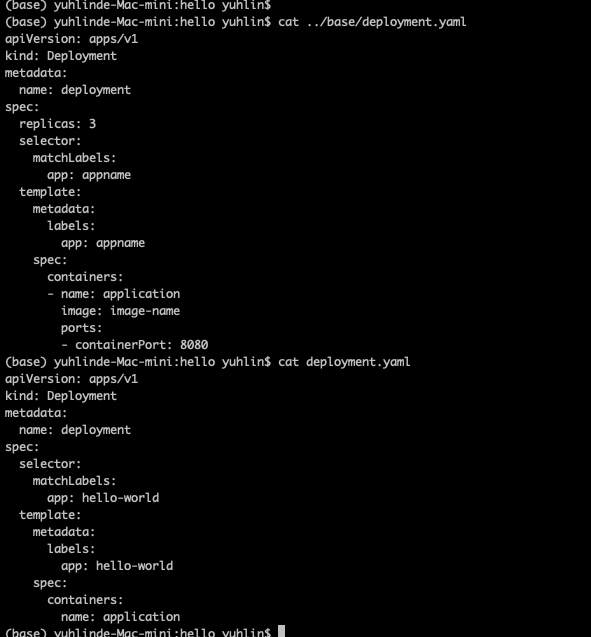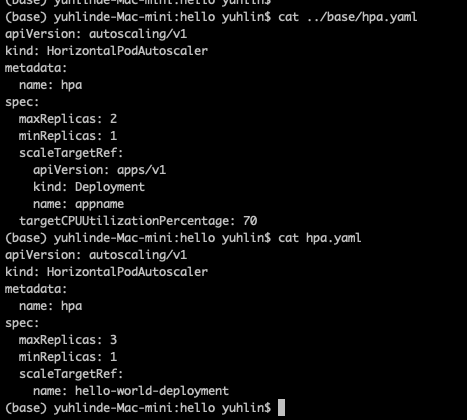day11 : argo gitops服务以及ingress (上)
花了好几天终於完成了所有的基础设施,接着就可以开始部署服务以及使用了,对於k8s来说要部署服务需要的其实只要yaml就可以了,最简单能够让外头使用的服务会需要几个yaml(deployment、service)基於istio还需要(virtualservice、gateway);而在我个人的认知上,布署服务的层面分为两个阶段,第一阶段是yaml管理,在这个阶段会将服务所需要的资源做成相对应的yaml并且管理好,第二阶段是operator,在这个阶段透过kubernetes的API通知k8s有resources需要新增异动,对於服务的布署,不太可能透过人为的方式用kubectl的指令或是api打给k8s,所以会仰赖cd流程去自动化的apply yaml的新增异动,那麽要如何自动的配置yaml就是今天的目标,
yaml的配置方法有很多种,新手入门的人可以简单的用shell的方式,优点是利用变数的方式填空很容易统一掌控服务的yaml,缺点就是不容易扩充而且有新功能的时候很容易叠着加上去,进阶一点的用法可以使用kustomize方式,优点是透过这样的方式扩充容易,而且是基於k8s而生具有较完整的支援,缺点就是如果没有管理好的情况,很可能让懂得使用的开发人员做出超出控制的yaml。
先来一段基础版
apiVersion: apps/v1
kind: Deployment
metadata:
name: hello-kubernetes
spec:
replicas: 3
selector:
matchLabels:
app: hello-kubernetes
template:
metadata:
labels:
app: hello-kubernetes
spec:
containers:
- name: hello-kubernetes
image: paulbouwer/hello-kubernetes:1.10
ports:
- containerPort: 8080
---
apiVersion: v1
kind: Service
metadata:
name: hello-kubernetes
spec:
type: ClusterIP
ports:
- port: 80
targetPort: 8080
selector:
app: hello-kubernetes
---
apiVersion: networking.istio.io/v1alpha3
kind: Gateway
metadata:
name: hello-kubernetes
spec:
selector:
istio: ingressgateway
servers:
- port:
number: 80
name: http
protocol: HTTP
hosts:
- hello-world.yuhlin.com.tw
---
apiVersion: networking.istio.io/v1alpha3
kind: VirtualService
metadata:
name: hello-kubernetes
spec:
hosts:
- hello-world.yuhlin.com.tw
gateways:
- hello-kubernetes
http:
- route:
- destination:
port:
number: 80
host: hello-kubernetes
另外因为我的示例中并没有使用lb转送服务,所以我用nodeport的方式解释会需要用到下述指令
export INGRESS_PORT=$(kubectl -n istio-system get service istio-ingressgateway -o jsonpath='{.spec.ports[?(@.name=="http2")].nodePort}')
export SECURE_INGRESS_PORT=$(kubectl -n istio-system get service istio-ingressgateway -o jsonpath='{.spec.ports[?(@.name=="https")].nodePort}')
export TCP_INGRESS_PORT=$(kubectl -n istio-system get service istio-ingressgateway -o jsonpath='{.spec.ports[?(@.name=="tcp")].nodePort}')
在简易设定好上面的指令後,设定ip和hostname到/etc/hosts,那麽观察一下浏览器,确实有成功的浏览到了呢,那麽前几天做的prometheus、loki等等有需要对外expose的服务也都可以依这个方式对外,而不是kubectl port-forward罗

那麽就来进阶的用kustomize玩耍yaml吧,应用kustomize会需要先有一个base目录放置yaml的雏形

像是图例中有基本的deployment、hpa、service
针对istio使用的vs、gw
对於openshift使用的route
kustomization.yaml中则是定义会运用到哪些base yaml。
准备好base後,就可以在另一个目录撰写kustomization.yaml说明服务需要依据base做哪些变动
namePrefix: hello-world
bases:
- ../base
patches:
- deployment.yaml
- service.yaml
- hpa.yaml
- vs.yaml
- gw.yaml
images:
- name: image-name
newName: my-registry/yuhlin/hello-world
newTag: 20210911v0
我以deployment和hpa为范例


其实这个做法看起来跟填空几乎没有两样,但是可以轻易的多加入更多参数(env、volume等等...),接着将其他yaml 想要加入的参数写好,这样我在这个目录中的服务就可以再根据base和这个目录下的patches去调整要变动的项目罗。
Day26 Cookie 的使用-1
cookie的使用方法: 这边我们用setcookie() 添加COOKIE值 setcookie(...
Day 10 学习线上服务思考用户的数位防身术-国内篇
昨天分享介绍国外线上服务思考用户的数位防身术设计方式,今天就回到国内来看看目前国内线上服务实作,分析...
第11章:控制背景运行服务介绍
前言 在上一章节中,介绍了有关於Linux作业系统上的process程序管理,以及取得主机上的CPU...
[Day 27] Bevy 游戏引擎 (Part 1)
昨天大概讲完 Rocket 的运用了 所以接下来就来介绍其他东西吧 这次要讲的是 Game Engi...
Day 20 - 研习计画之网站上线以及功能延伸开发篇
转眼间到11月网站也准备要上线了,回想当时很佩服研习生们有坚持住将该有的功能开发出来,另外昨日提到的...